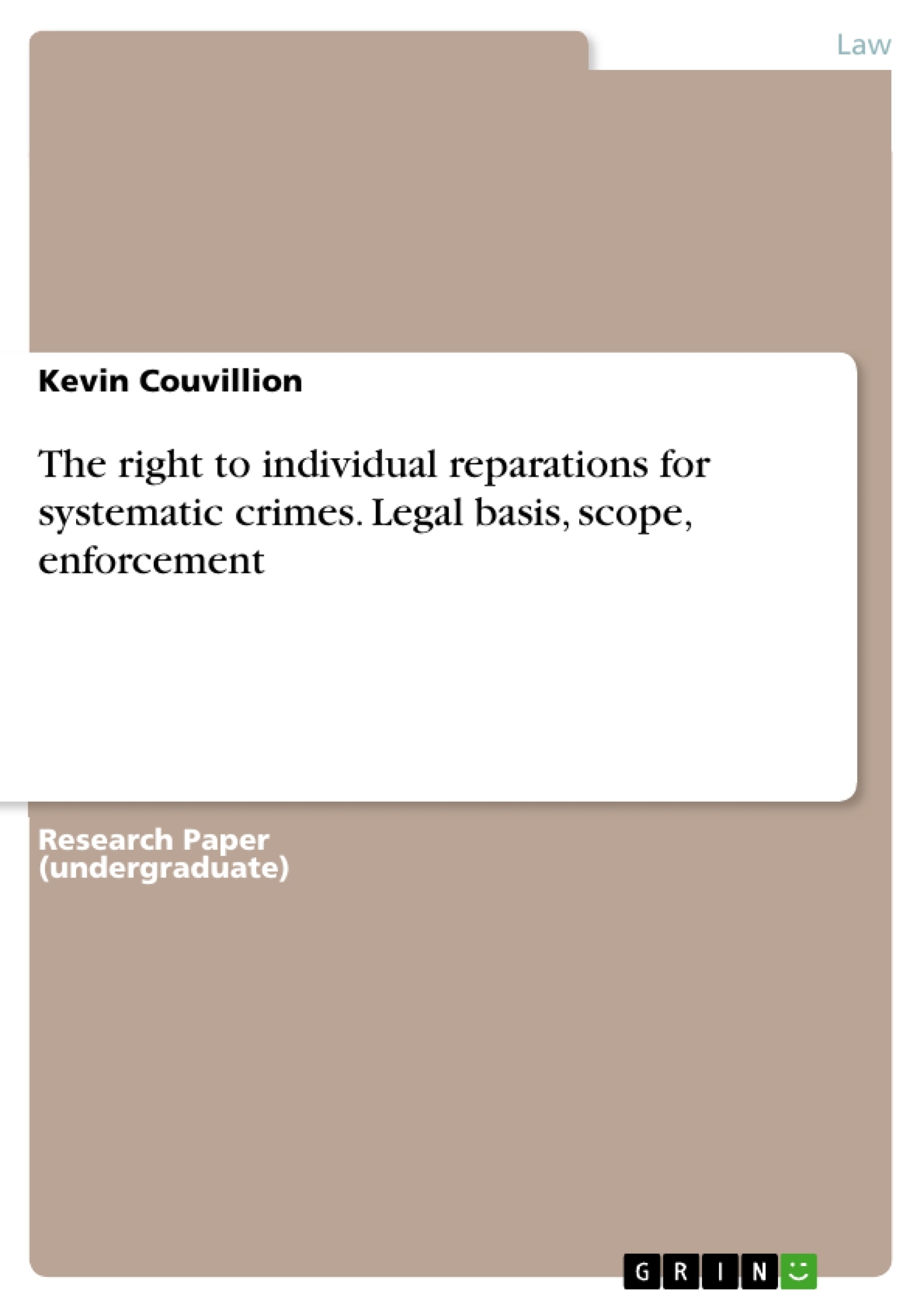The aim of this paper is to contour a normative model of reparations in transitional societies – alternatively dubbed as reparatory justice – and assess to what extent redress has become individualized and truly victim–oriented. It seeks to convey the vital demand associated with reparations: To restore the victim’s sense of dignity and moral worth and to remove his burden of disparagement often connoted with victimhood.
Throughout the past decades various states have emerged in processes of replacing pre–democratic political systems which have commissioned mass atrocities under an authoritarian rule. These young nations – often lacking a coherent institutional architecture and financial resources – are confronted with the mammoth task of instating a functioning government and developing a rule of law. Criminal prosecutions, lustration, truth commissions and a general notion of reconciliation – said “policies of coming to terms with the past” (stemming from its German original Vergangenheitsbewältigung) form the cornerstone of what is collectively described as transitional justice.
The arguably most important duty of transitional democracies, however, is to identify victims and perpetrators of the previous regime and to provide adequate redress for individuals without jeopardizing the newly found peace and stability. Much of the literary discussion has been criticized for poorly addressing the needs of victims and placing the issue of reparations on the sidelines. Further, transitional justice programs often had the practical effect of subordinating the individual victims to the majority’s desire to ignore the past. Several reparations initiatives have even been accused of re–victimizing the survivors or attempting to buy the victims’ silence.
Inhaltsverzeichnis (Table of Contents)
- I. On the Importance of a Right to Reparations
- II. The Notion of Reparations
- III. Personal and Material Scope of Application
- 1. Scope Ratione Personae: Individual
- 2. Scope Ratione Materiae: Systematic Crimes
- IV. Legal Basis
- 1. Historical Epitome
- 2. The Primacy of Fundamental Human Rights
- 3. Responsibility for Human Rights Violations
- 4. The Right to Individual Reparations
- a) The Position under General International Law
- b) International Human Rights Law
- aa) Global Instruments
- bb) Regional Instruments
- cc) Individuality of Human Rights Provisions
- c) International Humanitarian Law
- d) International Criminal Law
- e) UN Basic Principles on the Right to a Remedy
- V. Content of Reparations
- 1. Ranking the Types of Reparations
- 2. Human Rights Tribunals
- a) International
- b) Regional
- 3. International Criminal Court
- VI. Enforcement
- 1. International Human Rights Bodies
- 2. International Criminal Court
- 3. Administrative Programs/Mass Claims Procedures / Truth Commissions
- a) Administrative Reparations Programs
- b) Mass Claims Commissions
- c) Truth Commissions
- VII. Concluding Remarks
Zielsetzung und Themenschwerpunkte (Objectives and Key Themes)
This work aims to examine the legal basis, scope, and enforcement of the right to individual reparations for systematic crimes. It delves into the historical and contemporary context, exploring various international legal instruments and frameworks.
- The right to reparations for victims of systematic crimes
- The scope of application of reparations, including individual and material dimensions
- The legal basis of the right to reparations under international law
- The various types and content of reparations, including restitution, compensation, rehabilitation, and satisfaction
- The enforcement mechanisms for ensuring reparations for victims
Zusammenfassung der Kapitel (Chapter Summaries)
- Chapter I: This chapter establishes the importance of a right to reparations for victims of systematic crimes. It argues that such a right is crucial for promoting justice, accountability, and reconciliation.
- Chapter II: This chapter defines the concept of reparations, outlining its different forms and objectives. It also explores the historical and philosophical underpinnings of reparations.
- Chapter III: This chapter examines the scope of application for individual reparations. It defines the target group (individuals) and the types of crimes (systematic crimes) for which reparations are applicable.
- Chapter IV: This chapter delves into the legal basis of the right to reparations. It explores various sources of international law, including general international law, human rights law, humanitarian law, and criminal law.
- Chapter V: This chapter analyzes the content of reparations, categorizing different types and ranking their importance. It also examines the role of human rights tribunals and the International Criminal Court in providing reparations.
- Chapter VI: This chapter discusses the enforcement mechanisms for ensuring reparations for victims. It examines the roles of international human rights bodies, the International Criminal Court, and administrative programs.
Schlüsselwörter (Keywords)
The key themes and concepts explored in this work include: reparations, systematic crimes, individual rights, international law, human rights law, humanitarian law, criminal law, human rights tribunals, international criminal court, enforcement mechanisms, accountability, justice, and reconciliation.
- Quote paper
- Kevin Couvillion (Author), 2016, The right to individual reparations for systematic crimes. Legal basis, scope, enforcement, Munich, GRIN Verlag, https://www.grin.com/document/391354



